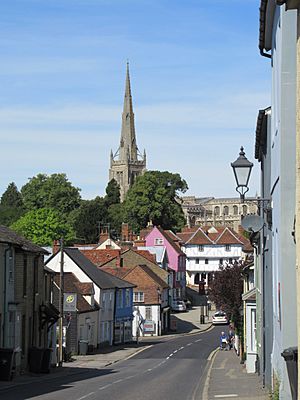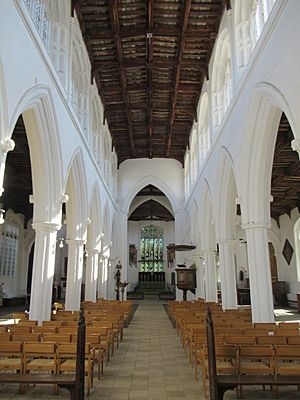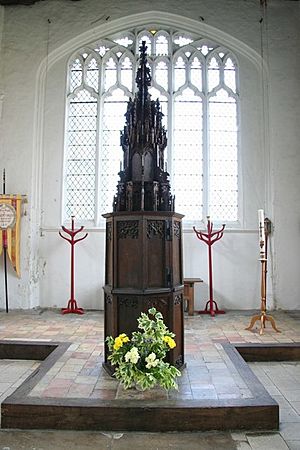Thaxted Parish Church facts for kids
Quick facts for kids Thaxted Parish Church |
|
|---|---|
| Church of Saint John the Baptist with Our Lady and Saint Laurence | |
| "The Cathedral of Essex" | |
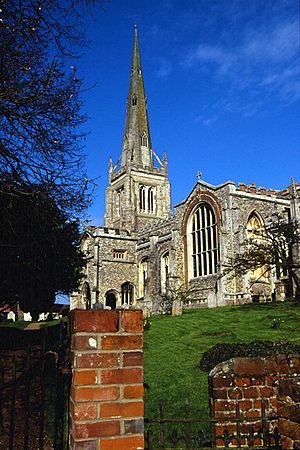
Thaxted Church, with its spire and south porch, viewed from the top of Stony Lane
|
|
| 51°57′16″N 0°20′32″E / 51.954319°N 0.342295°E | |
| OS grid reference | TL 61044 31014 |
| Location | Thaxted, Essex |
| Country | England |
| Denomination | Church of England |
| Previous denomination | Catholicism |
| History | |
| Dedication | Saint John the Baptist; Our Lady; Saint Laurence |
| Architecture | |
| Heritage designation | Grade I listed building |
| Architectural type | Church |
| Style | English Perpendicular |
| Years built | c. 1340 to c. 1510 |
| Specifications | |
| Length | 183 feet (56 m) |
| Width | 87 feet (27 m) |
| Spire height | 181 feet (55 m) |
| Administration | |
| Parish | Thaxted |
| Benefice | Thaxted, The Sampfords, Radwinter and Hempstead |
| Deanery | Saffron Walden |
| Archdeaconry | Stansted |
| Diocese | Chelmsford |
| Province | Canterbury |
The Church of Saint John the Baptist with Our Lady and Saint Laurence is a beautiful old church in the town of Thaxted, Essex, England. It is often called "the Cathedral of Essex" because it is so large and grand. The church was built over many years, from around 1380 to 1510. It is designed in a style called Perpendicular Gothic, which means it has tall, slender features and lots of windows.
Sitting on a hill, the church has a tall, thin spire that reaches 181 feet (55 meters) high. It looks out over the town and the countryside. The church's large size shows how rich Thaxted used to be. In medieval times, the town was famous for making cutlery and wool. The church is a very important historical building, listed as Grade I on the National Heritage List.
"The town of Thaxted is the queen of Essex and her crown is the church. The steeple stands out over the surrounding fields. The town streets all seem to bend in its direction over ancient cobbles and past timber framed houses." — Simon Jenkins, Country Churches, Penguin English Journeys, 2009, p.36.
Since 2017, Thaxted Church has been part of a larger group of churches. It belongs to the Diocese of Chelmsford. Before that, it was part of other dioceses like London, Rochester, and Saint Albans.
Contents
History of the Church
How the Church Began
People have worshipped in Thaxted for a very long time, even since Saxon times. The first mention of a church here was between 981 and 1016. A woman named Æthelgifu gave land to a monastery, and her will was kept in the church as proof.
It is believed that an earlier church, dedicated to Saint Catherine, stood near the current site. There is also evidence that the present church was built on top of an even older one.
You might wonder why a small town like Thaxted built such a huge church in the 1300s. Several things helped make it possible. The town was becoming wealthy from its cutlery industry. Also, there was a disagreement between the local priest and the monks of Tilty Abbey over money. This meant that funds that used to go to the abbey could now be used for the parish church.
The people of Thaxted worked together to raise money for the building. Rich families, like the Clare family, also helped pay for the church. These important sponsors included Elizabeth de Clare, Lionel, Duke of Clarence, and even King Edward IV.
Building the Church
The church you see today was built over a long time, from the mid-1300s to the early 1500s. The oldest parts of the building date back to around 1340. The main construction was finished by about 1510. Some parts of an older church were found under the main altar area (chancel). Some people think the old church stayed in use while the new one was being built around it.
It is hard to know the exact order of construction, but here is a general idea:
- The main part of the church (nave) and its side aisles were built around 1340.
- The south transept (a side arm of the church) and a wider south aisle were added between 1360 and 1380.
- The south porch was built around 1380.
- The north transept was added between 1380 and 1420.
- The north porch and a wider north aisle were built around 1445.
- The tall west tower and spire were completed between 1475 and 1500.
- The chancel (area around the altar), chapels, and upper windows (clerestory) were finished around 1510.
Some experts believe the original plan might have included a tower in the middle of the church, which might have fallen down.
Repairs Over the Years
Thaxted Church has been repaired many times, but people have always been careful not to change its original look too much. As early as 1561, people were asking for money to fix the "fair edifice."
Storms caused damage in the 1700s and early 1800s. In 1814, a lightning strike and a "hurricane" badly damaged the spire and roof. It took several years to rebuild the spire exactly as it was before, with help from Sir William Smyth.
Later, in 1909–10, an architect named Randall Wells worked on the church. He removed old cement and made the tower's foundations stronger. Fundraising continues today to keep the church in good condition.
Interesting Stories About the Clergy
The church and its priests have been part of some interesting events over the centuries. In 1314, there was a disagreement between the priest, William, and the monks of Tilty Abbey. The monks refused to help pay for the church. The townspeople, who were becoming richer, decided to support the church themselves. This led to more money coming in, which helped start the big rebuilding project.
In the early 1400s, Thaxted was a place where people had different religious ideas, known as Lollardy. Some priests and residents faced serious consequences for their beliefs.
During the English Civil War in the 1600s, there was a big argument about who should be the vicar. Different groups in the town supported different candidates. This even led to a "great fight" in the church! Eventually, a Puritan candidate, James Parkin, became vicar, but he was later removed.
In 1922, the church became famous for the "Battle of the Flags." The vicar, Conrad Noel, who was a Christian Socialist, hung the Red Flag and the Irish Tricolour alongside the Union Flag in the church. This caused a lot of debate and arguments. Students from Cambridge University even tried to take the flags down! Eventually, the church leaders ordered them to be removed. Conrad Noel's ideas and actions led to a special "Thaxted tradition" of vicars who were interested in social and political issues.
The composer, Gustav Holst, was the church organist from 1917 to 1925. He started an annual festival in the church. He also wrote many hymns and carols for the church, including the famous tune "Thaxted" for the hymn "I Vow To Thee My Country."
Almost a Cathedral
Thaxted Church is sometimes called the "Cathedral of Essex" because of its size. In the early 1900s, it was even considered to become a real cathedral! A new bishopric (area led by a bishop) was being planned. Thaxted was one of seven churches that applied. It was already grand enough and would not have needed big changes. However, another town, Chelmsford, was chosen instead.
Church Architecture
Thaxted Church is a great example of the Perpendicular Gothic style. This style is known for its tall, straight lines and large windows. Pevsner, a famous architectural historian, described it as "proud, spacious, clear and a little frigid inside."
The outside of the church is made of limestone and flint. It has battlements (like on a castle) and buttresses (supports) with pinnacles and gargoyles. The exterior is decorated with carvings of figures and designs.
The west tower holds the church bells and supports the tall spire. It was built in the 1400s and has been repaired many times. The spire is 181 feet (55 meters) high and has small windows. A golden weather vane sits at the very top.
There are two main entrances, called porches, each with two floors.
- The south porch, or Duke's Porch, was given by Lionel, Duke of Clarence in the 1360s. It has a star-shaped ceiling design.
- The north porch, or King's Porch, was given by King Edward IV. It is taller and more decorated, with carved figures and a small tower. The room above this porch was dedicated by Conrad Noel as a chapel to John Ball, a leader from the Peasants' Revolt. Most people enter the church through the North Porch today.
Inside, the main part of the church (nave) is 85.5 feet (26 meters) long and 18.5 feet (5.6 meters) wide. The side aisles are even wider than the nave. The wooden roof throughout the church is original, with carved designs of heads, angels, and leaves. The upper windows (clerestory) were added in the early 1500s.
The north and south transepts are the "arms" of the church. The south transept might have once been a chapel dedicated to Saint Catherine.
The chancel (the area around the altar) and its side chapels are the newest parts of the building, finished before 1510. The north chapel is called the Becket Chapel, and the south chapel is called the Lady Chapel.
Church Features
The font, used for baptisms, is in the north-western corner. It has a beautiful wooden cover from the late 1400s. The hexagonal pulpit, where sermons are given, is from the 1680s and has carved designs.
Some of the stained glass windows are very old, from the 1300s and 1400s. One shows a knight, possibly Edmund Mortimer, 5th Earl of March. Other old glass shows Adam and Eve, Saint Christopher, a watermill, and a ship. The large windows at the east end of the church were made in 1900 by a famous artist named Charles Eamer Kempe.
The church has two organs. The Lincoln Organ, built in 1821, is a rare old instrument that has been fully restored. It is used for concerts. The smaller Conrad Noel Memorial Organ was installed in 1952, named after the former vicar.
A large, star-shaped candelabra hangs in the middle of the church. It was installed in 1911 by Conrad Noel. It represents the family tree of Christ. There is also an old German or French statue of the Madonna, given by the artist Fred Uhlman.
Monuments and Famous Connections
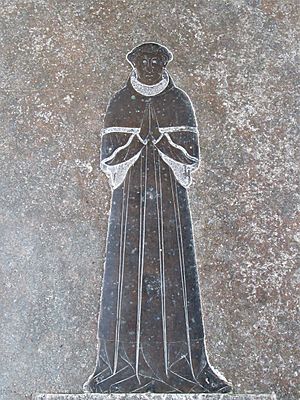
On the floor of the chancel, there is a brass carving of a priest from the 1400s. It is thought to be Robert Wydow, a poet, musician, and clergyman who was born in Thaxted. He was the vicar here from 1481 to 1489. Other memorial stones are also in the church floor.
Above the south door hangs the Royal Arms of Queen Anne, painted on wood. It was restored in 1980.
A five-foot tall statue of St Francis of Assisi is in the north transept. It remembers Eric Makeham, who died in 1917 during World War I. His name is also on a memorial in Belgium. In the churchyard, there is a war grave for Private Edward Stamfield Brown, who died in 1919.
A bronze statue of Conrad Noel is in the church, made by the sculptor Gertrude Hermes.
On the outside wall of the church tower, there is a large stone plaque. It is Thaxted's war memorial, remembering "THOSE MEN AND WOMEN OF THAXTED WHO HAVE GIVEN THEIR LIVES IN THE SERVICE OF OTHERS & IN THE CAUSE OF FREEDOM."
The famous composer, Gustav Holst, was the church organist from 1917 to 1925. He lived in Thaxted and organized an annual festival in the church. He wrote many hymns and carols for the church choir. One of his most famous tunes, "Thaxted," is used for the hymn "I Vow To Thee My Country."
Church Bells
The church has a set of eight bells that are used for change ringing. The oldest bells were made in 1734. Other bells were cast in 1778 by a famous company called Mears & Company in London. The remaining four bells were made in the 1940s.
These four newer bells have special names:
- No. 3 is the Justice Bell.
- No. 5 is the Peace Bell.
- No. 7 is the Craft Bell.
- No. 4 is the Dance Bell. This bell has a special message: "I ring for the general dance." This comes from a carol that Gustav Holst set to music for the Thaxted Church Choir.
The new bells were officially dedicated in 1949.
| No. | Note | Significance | Inscription | Weight |
|---|---|---|---|---|
| 1 | E♭ | Treble | Recast by voluntary subscription 1778
Mears & Co London fecit |
3 cwt
3 qrs 18 lbs |
| 2 | D | Raised by voluntary subscription 1778
Mears & Co London fecit |
4 cwt
1 qr 22 lbs |
|
| 3 | C | The Justice
Bell |
He hath made of one blood all Nations
I ring for justice in all the Earth And I John saw the Holy City of Jerusalem Coming down from God out of Heaven Prepared as a bride adorned for her husband
Mears & Co London fecit Gillett & Johnston Croyden refecit 1949 Jack Putterill – Vicar Stanley Wilson / William Barker – Churchwardens Donors: The People of Thaxted and friends |
5 cwt
1 qr 1 lb |
| 4 | B♭ | The Dance
Bell or the Fellowship Bell |
I ring for the General Dance
Praise him in the cymbals and dances Praise him upon the strings and pipe
Gillett & Johnston Croyden refecit 1949 Jack Putterill – Vicar Stanley Wilson / William Barker – Churchwardens Donors: The Morris Ring and the Friends of Thaxted |
6 cwt
3 qrs 2 lbs |
| 5 | A♭ | The Peace Bell | Gloria in Excelsis Deo et in Terra Pax
Hominibus Bonae Voluntatis I ring for universal peace And I heard a great voice out of heaven saying Behold the Tabernacle of God is with Men And He will dwell with them And they shall be His people And God shall wipe away all tears from their eyes And there shall be no more death Neither sorrow nor crying Neither shall there be any more pain For the former things are passed away And God himself shall be with them, and be their God
Gillett & Johnston Croyden reflect 1948 Jack Putterill – Vicar Stanley Wilson / William Barker – Churchwardens Donors: Thaxted Church and the Patron |
8 cwt
2 qrs 25 lbs |
| 6 | G | Ios Saward / Iohn Westwood
Church Wardens 1734 |
9 cwt
3 qrs 4 lbs |
|
| 7 | F | The Craft Bell | Ioseph Saward / Iohn Westwood
Church Wardens 1734 |
12 cwt
1 qr 14 lbs |
| 8 | E♭ | Tenor | Richard White Vicar Thomas Brand
& Mathew Randall Church Wardens 1778 Mears & Co fecit
|
15 cwt
2 lbs |
| The three recast bells bear the following symbols: a gridiron, representing Saint Laurence (No. 3); a hand during water surrounded by a halo, representing Saint John the Baptist (No. 4); and a winged heart pierced, representing Our Lady (No. 5) | ||||
List of Vicars
The church has had many vicars (parish priests) over the centuries. In 1227, the role of vicar was created because the townspeople wanted a priest living in Thaxted. For a long time, the right to choose the vicar belonged to the Maynard family. In the 1920s, this right was sold. Now, the Diocese of Chelmsford chooses the vicar.
Here is a list of some of the vicars of Thaxted Parish Church:
| From | To | Name | End of tenure | Notes |
|---|---|---|---|---|
| Before the Reformation (Catholic) | ||||
| Late 13th century | ? | Thomas | Believed to be the first vicar. | |
| 1314 | ? | William | He had a disagreement with the monks of Tilty Abbey over money for the church. | |
| ? | 1332 | William Pamphilus or Pamphilon | ||
| 1349 | Walter de Salesbury | |||
| 1349 | 1351 | John de Harewold | Exchange of benefice | Moved to Moreton, Essex. |
| 1351 | ? | John Bele or Bell | Came from Moreton, Essex. | |
| 1377 | ? | Thomas Ufford | ||
| c.1401 | 1431? | William | A Lollard preacher, he faced challenges for his beliefs. | |
| ? | 1407 | Robert Wytton | Exchange of benefice | Moved to Earsham, Norfolk. |
| 1407 | 1410 | Thomas de Orton | Resigned | Came from Earsham, Norfolk. |
| 1410 | 1427 | John Deye (of Brampton?) | ||
| 1427 | ? | John Everden | ||
| ? | 1467 | William Shaw | ||
| 1459 | ? | Thomas Groswyll? | ||
| 1467 | 1470 | Nicholas Rewys or Rewes, Raynes | Resigned | |
| 1470 | ? | Richard Edenham | Consecrated bishop | Later became Bishop of Bangor. |
| 1470 | 1471 | Hugo Edenham alias Wyrall or Wyvale | Resigned | Brother of the previous vicar. |
| 1471 | 1476 | David Steward | Resigned | |
| 1476 | 1481 | Thomas Halyday | Resigned | |
| 1481 | 1489 | Robert Wydow | Resigned | Born in Thaxted. A famous poet and musician. |
| 1489 | after 1495 | Richard Roston | ||
| ? | 1519 | Miles Hodgeson | Died | |
| 1520 | 1523 | Thomas Reynes | Resigned | |
| 1523 | 1528 | Edward Staples | Later became Bishop of Meath. | |
| 1528 | 1534 | Nicholas Wilson | Removed | He disagreed with King Henry VIII. |
| After the Reformation (Church of England) | ||||
| 1534 | 1539 | John Skypp | Consecrated bishop | Later became Bishop of Hereford. |
| 1539 | 1546 | William Motte | Resigned | |
| 1546 | 1561 | John Puysaunt | Died | |
| 1566 | 1566 | William Bowen | Died | |
| 1566 | 1583 | Thomas Halliday | Died | |
| 1583 | 1612 | Thomas Crosby | Died | |
| Civil War Period (Disputed) | ||||
| 1612 | 1645 | Newman Leader | Removed | |
| 1645 | 1646 | Edmund Croxton | Removed | |
| 1646 | 1647 | Samuel Hall | Removed | |
| 1648 | 1662 | James Parkin | Removed | He stayed in Thaxted as a non-conformist preacher. |
| After the Restoration (Church of England) | ||||
| 1662 | 1670 | John Curtis | Died | |
| 1670 | 1724 | Robert Bernard | Died | The longest-serving vicar of Thaxted. |
| 1724 | 1735 | Henry Oborne Sr. | Died | |
| 1735 | 1752 | James Allen | Died | |
| 1752 | 1759 | Henry Oborne Jr. | Died | |
| 1759 | 1780 | Richard White | Died | |
| 1780 | 1782 | Claudius Martyn | Died | |
| 1782 | 1806 | Henry Maynard | Died | His family held the right to choose the vicar. |
| 1806 | 1853 | Thomas Jee | Died | |
| 1853 | 1854 | Edward Hanson | Died | |
| 1854 | 1859 | Court D'Ewes Granville | Resigned | |
| 1859 | 1893 | George Edward Symonds | Died | |
| 1893 | 1910 | Leonard Sedgwick Westall | Resigned | |
| 1910 | 1942 | Conrad Le Dispenser Roden Noel | Died | Known as "The Red Vicar of Thaxted." |
| 1942 | 1973 | John Cyril "Jack" Putterill | Resigned | Conrad Noel's son-in-law. |
| 1973 | 1984 | Peter Charles Edward Elers | Resigned | |
| 1984 | 1989 | Timothy John Fawcett | ||
| 1989 | 2000 | Richard Nigel Rowe | Resigned | |
| 2000 | 2013 | Raymond Montgomery Taylor | Retired | |
| 2014 | 2015 | Paul David Christopher Brown | ||
| 2016 | 2021 | Philip Geoffrey Tarris | Retired | Rector. Part of a larger group of churches since 2017. |
| 2023 | 2024 | Gerwyn Capon | Resigned to become Archdeacon of Montgomery | Former Dean of Llandaff |
Images for kids
-
Thaxted Church, gargoyle


